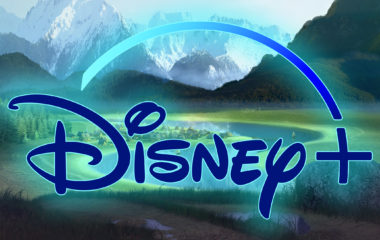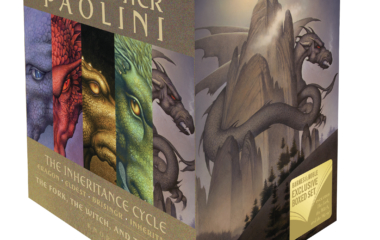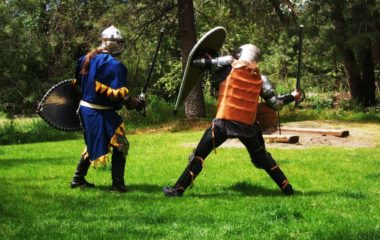Readers can find dozens of Christopher’s every day nods and inspirations woven throughout the Inheritance Cycle. Many of these references require a sleuth’s eye, while other secrets are offered readily. This article is the first in a series exploring the quirks of the land of Alagaësia and its peoples.

Angela the herbalist – Initially based on Christopher’s sister, whose affinity for knitting, herbalism, and unique words shine through in each storied interaction with her doppelganger character.
Az Knurldrâthn (Forest of Stone) – The petrified trees found within the Beor Mountains are based on real locations, such as the Yellowstone Petrified Forest and and Petrified Forest National Park in Arizona.

Baldor (son of Horst and Elain) – The character is named after Christopher’s uncle Bruce.
Barges? We don’t want no stinking barges! – In Eldest, Loring the cobbler shouts this nod to the film The Treasure of the Sierra Madre.
Bid’Duam – The first dragon to be paired with a Rider is hiding another secret: his name spelled backward yields Muad’Dib, the name of the main character from the novel Dune.
Brom – Named after the popular American fantasy artist whose work was featured in the 10th anniversary edition of Eragon. The character was also loosely based on Christopher’s father, Kenneth.

Cadoc – The horse’s name was an unexpected nod to the photography company Kodak (spelled backward, but with Cs).

Doctor Who makes several appearances throughout the books, including:
• “Lonely god” – Arya mentioned a lonely god while sketching runes on the ground in Brisingr. This was a reference to the television series’ titular character.
• “Raxacori-“ – When asked about a set of runes she was knitting into a hat, Angela responded: “Raxacori- Oh never mind. It wouldn’t mean anything to you anyway.” Raxacoricofallapatorius, home of the Raxacoricofallapatorians, is a fictional planet in the Doctor Who universe.
• “Bigger on the inside” – On the show, the Doctor’s T.A.R.D.I.S. is often described in an ongoing/running gag as being “bigger on the inside.” Solembum may have encountered the time-traveling spaceship, saying “I have seen things that defy belief: whirlwinds of light spinning in caverns deep below the ground, men who age backward, stones that speak, and shadows that creep. Rooms bigger on the inside than the outside…”
Dragon scales – The gemstone colors of Alagaësian dragons’ scales were derived in part from the iridescent feathers of hummingbirds.
Dwarf caves – The caves running beneath the Beor Mountains were partially inspired by the Carlsbad Caverns in New Mexico and the Lewis and Clark Caverns in Montana.

Eragon – Christopher used his daydreams of dragon riding, swordfighting, and epic battles to write the first draft of Eragon. As a result, early versions of the character Eragon were based on the author himself.

Frogs vs. toads – Angela the herbalist’s frogs vs. toads conundrum was taken from an actual conversation between Christopher and Angela.

Helgrind – This terrifying rock formation was inspired by Shiprock Peak in New Mexico and means “The Gates of Death” in Old Norse.
Hrothgar – The name Hrothgar comes from the epic Beowulf, one of Christopher’s favorite stories.

Killer Rabbit – Monty Python fans may immediately recognize this nod to the Killer Rabbit of Caerbannog from Monty Python and the Holy Grail.

Morn – Carvahall’s tavern keeper was named after an alien from the popular sci-fi television saga Star Trek: Deep Space Nine.

Palancar Valley – The valley and its namesake character were so titled as a tribute to the artist John Jude Palencar. Without knowing this, Random House would eventually choose Palencar to paint the cover art for the books—an amazing coincidence! The valley was inspired by Christopher’s home, Paradise Valley, Montana.
Puzzle ring – This gift from Orik was based on a puzzle ring given to Christopher by a librarian during a book tour for the self-published edition of Eragon.

Ra’zac – The Ra’zac’s grim appearance was initially inspired by Jerusalem crickets, creatures Christopher dislikes!
Rimgar – These steps in a Rider’s training were drawn from yoga movement sequences.

Saphira – Her name was derived from “sapphire,” the beautiful blue gem. The color is Christopher’s favorite, so he imagined her with brilliant sapphire-blue scales, polished to a mirror-like sheen.
Shrrg – Massive wolves native to the Beor Mountains, the Shrrg were based on the timber wolf. Christopher invented the name after thinking about the sound of a dog’s growl.
Shruikan – The name is a play on “shuriken,” a star-shaped martial arts throwing weapon.

Toll bridge – The scene in which a toll bridge keeper attempts to swindle Eragon and Brom was a nod to The Ruby Knight by David Eddings.
Talitá – The boat Eragon sailed away on at the end of Inheritance was named after Christopher’s mother.

Urgal horns – These fear-inducing features are similar to those of the Feldûnost, which resemble those of the bighorn sheep.
Urzhad – Based on the extinct giant cave bear. The most similar creature alive today is Alaska’s Kodiak bear.

Vanir – The name of a group of Norse gods associated with fertility, wisdom, nature, magic, and the ability to see the future.

Werecats – At the suggestion of his sister, Christopher derived the physical appearance of werecats from the caracal, a species of medium-sized cat native to Africa and western Asia.

Yazuac – This razed village’s name was a near anagram for the Yakuza, the Japanese Mafia.




